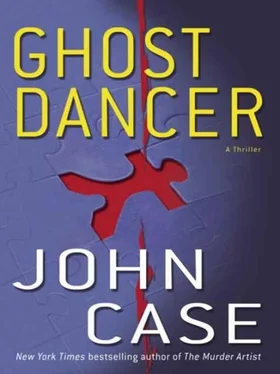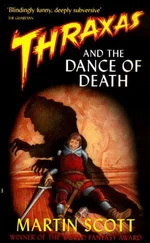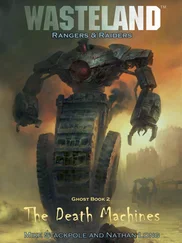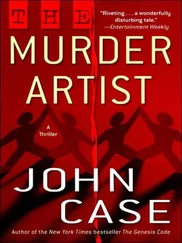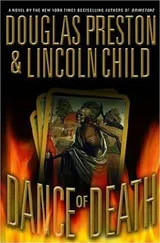Zero and Khalid were talking and laughing when a dusty pickup truck with improvised armor appeared at the end of the alley. Zero got to his feet, shooing the truck with his hand. The driver ignored the gesture, and began to back into the alley, ever so slowly. As he did, the truck began to emit a slow beep, warning people out of the way. Beep beep beep.
Khalid jumped to his feet with a shout, yelling angrily at the driver to get out of the alley. Beep beep – Khalid fired a warning shot into the air. And then the truck accelerated.
There was nowhere for them to go. The truck was almost as wide as the alley. In a panic, the boys fumbled with their guns, finally getting off a burst of shots, as they staggered backward into the concrete wall of Big Ping’s emporium.
There was a shriek of panic, and one of them (Wilson thought it was Khalid) screamed “Mr. Frank!” Then the truck slammed into them, cutting Zero in half and mangling Khalid from the hips down.
The building shook, but Wilson couldn’t take his eyes away. Watching the scene in the alley was like watching an anaconda devour a pony. It was horrible and mesmerizing all at once. The truck rolled slowly forward a couple of feet, its tailgate dripping. Khalid lay writhing on the ground, his right arm thrashing uncontrollably, as the driver shifted into reverse. Beep beep – The truck rolled over them, and the building shivered a second time.
The warning signal stopped as the truck rolled back the way it had come out, and stopped. The driver’s window rolled down, and da Rosa stuck his head out from behind the steering wheel. Seeing the mess at the end of the alley – his handiwork – he gave the men on the second floor a thumbs-up.
Big Ping nudged Wilson with his elbow and, grinning, said, “Like… fly swattah !”
BERLIN | MARCH 16, 2005
Just the sight of her irritated Pete Spagnola. Which was not good, since she was his deputy and Spagnola saw her three or four times a day. A Smith graduate, she was arrogant, ambitious, and, though still nominally young, fat enough to seem almost matronly. Even her gender-bending name pissed him off. Madison Logan. It sounded like an airport.
Because of something powerful and armored in her physique, he had, in a moment of inspiration, dubbed her “Humvee.” The name was so apt that it prompted guilty laughter the one time he’d let it slip. But it had gotten back to her, of course. (That was one of the problems: Everything got back to her.)
He was himself, by his very nature, a risk taker. That’s what had driven him to join the Central Intelligence Agency – his love of adventure. It was an irony of fate, then, that a guy who might have prospered as a NASCAR driver or a jungle guide had ended up mired in such a stolid bureaucracy. The Agency, once proud of its nimble and bold spies, had long ago adopted a don’t-rock-the-boat mentality so profound that even the collapse of the Soviet Union had gone unremarked upon until after the fact. (To have mentioned it earlier would have encouraged budget cuts.)
To make matters worse, Spagnola worked under embassy cover. He spent his days laboring among the worker bees of the State Department, a bureaucracy even more constipated than the Agency’s own.
Eighteen years of keeping his head down, and more or less going through the motions, had nearly extinguished his ability to pay attention to his work, except in the most superficial way.
So when Humvee tapped on his office door, and Spagnola gestured her in, he wasn’t really listening to what she said. Not at first, anyway. She was talking a mile a minute, like his daughter did, Bugs-Bunny-fast, a veritable burst-transmission.
He was wondering if he could wangle an extra day’s leave so he could take the family skiing. And he was thinking about the recent volatility of one of his investments, a Canadian natural gas play in Kazakhstan.
But some intensity of focus on Humvee’s part got through to him, or maybe it was the name she dropped: Bobojon Simoni.
Simoni was the al-Qaeda operative who’d gotten himself killed two weeks earlier, when the BfV raided his Berlin apartment. “What?”
“I said we made a mirror image of Simoni’s computer, and when we took a look at it, we found an application called Stegorama.”
Spagnola frowned. “Stegorama?”
“It’s a steganography program. In this case, freeware – you can download it from the Net. You know what steganography is?”
“What’s the difference? You’re going to tell me anyway, right?”
A patient sigh. “It means ‘hidden writing,’” she said. “That’s what it means in the Greek, literally.”
“Okay…”
“But in this case it means information that’s concealed in pictures. Or music files.”
“And how do you hide a message in a picture – or a song?”
The Smithie in her smirked. “Digital information is just digital information,” she revealed. “A graphic file or an audio file is still composed of bits and bytes, just like a text file. With a program like Stegorama – and there are dozens of them – you can embed information in the image. You could put two photographs of the same thing, taken from the same angle, side by side, and they’d look identical. But the one containing encrypted data is actually a compressed version of the original. You just can’t see the difference without a microscope.”
Spagnola was interested now. “Realllly!”
“Yes,” Humvee said. “Really. The Steg programs decide which parts of the image are least important to its visual integrity, and that’s where the cipher is embedded. It’s hidden in the boring bits, so to speak. In the background, or whatever.”
“And Simoni was doing this?”
She shrugged. “He had the program. So we sent his computer to the States. They were working their way through the graphic files. He had a couple of hundred JPEG files in the Pictures folder. So the search was glacial. But they found what they were looking for-”
“Messages?”
“Statistical deviations in the byte counts. They could tell there were too many bytes in the files, which is a dead giveaway.” She paused. “But, yes,” she said in a grudging voice, “there were ‘messages’ in the pictures. Encrypted messages. NSA’s working on the decrypts now.”
Spagnola frowned in thought. “So… I don’t get it. Where were the pictures going?”
Humvee pursed her lips. Finally, she said, “Remember the book they found?”
“In Simoni’s apartment.”
“Exactly.”
Spagnola nodded. “Yeah, it was a Koran or something. He had it wrapped up like it was a bomb.”
“And he was mailing it to a bookstore in Boston,” Humvee reminded him.
“Right.” Suddenly, his eyes widened as if a lightbulb had gone off inside his head. “So he was communicating with someone in the bookstore!”
Humvee shook her head. “No, the bookstore owner didn’t know squat. The Bureau sent a couple of agents to interview him – and the guy is exactly what he seems to be: someone who buys old books.”
“Then what’s the point?” Spagnola asked, frustrated that he had to tease the information out of this great block of feminine pulchritude.
“The Bureau asked him how he came to buy this particular book, and guess what he tells them? He tells them he found it on eBay.” She waited for Spagnola to connect the dots.
“You mean-”
She nodded. “Simoni was posting his pictures on eBay auctions, so anyone could access them. If you had the Steg program and knew where to look, you could find the messages, no problem.”
“And the books?”
“Forget the books,” Humvee told him. “The only reason Simoni delivered the books was to back up his cover. Otherwise, eBay would have bounced him.”
Читать дальше
